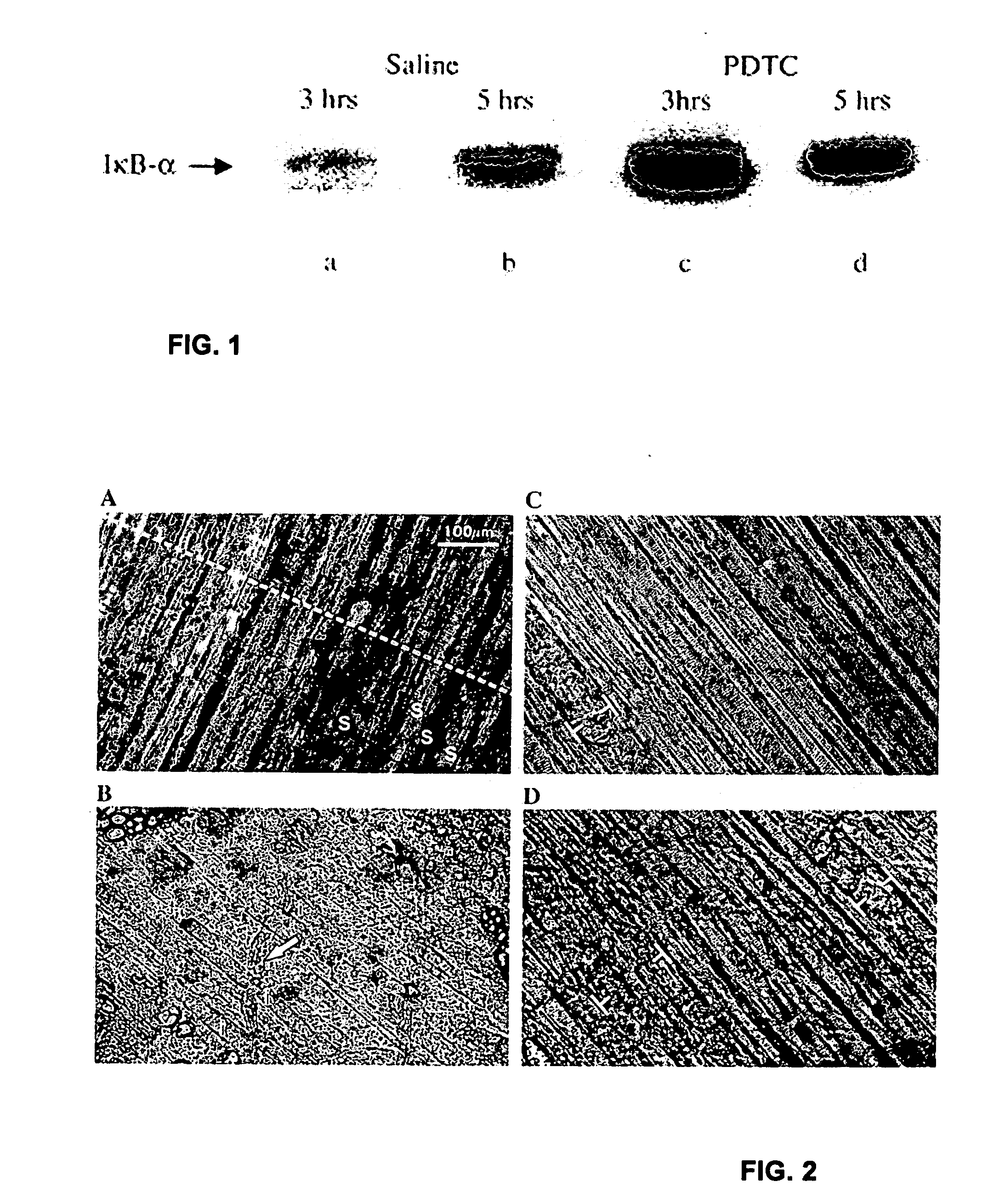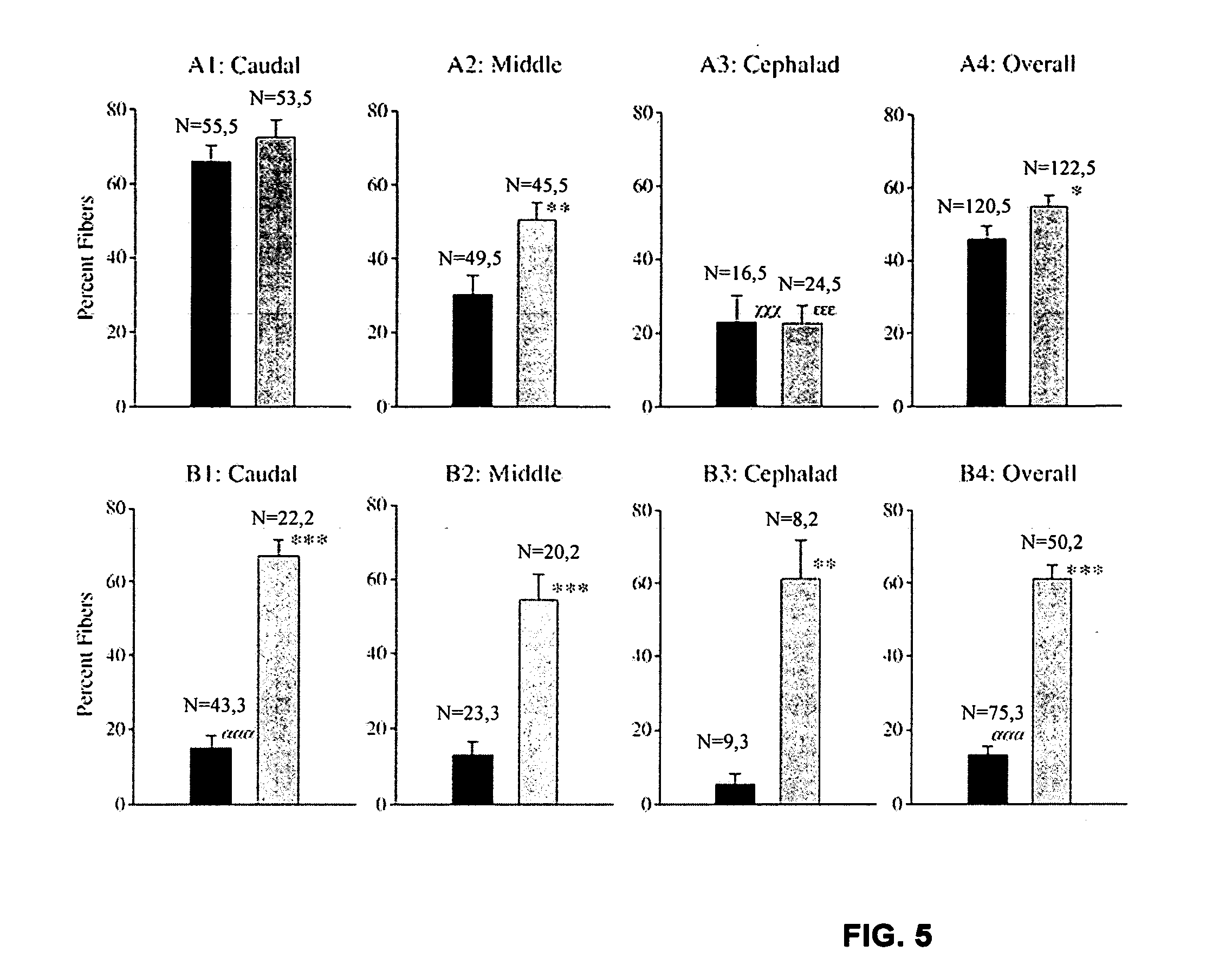Compositions and methods for the treatment of muscular dystrophy
a technology of compositions and methods, applied in the direction of drug compositions, ketone active ingredients, plant/algae/fungi/lichens ingredients, etc., can solve the problems of slow disease progression, many of these treatments are ineffective, and have severe side effects, so as to achieve long-term treatment, less efficacy, and less efficacy
- Summary
- Abstract
- Description
- Claims
- Application Information
AI Technical Summary
Benefits of technology
Problems solved by technology
Method used
Image
Examples
example 1
PDTC May Stabilize Cytosolic IκB-α in Adult mdx Skeletal Muscle
[0133] Previous studies have shown that PDTC reduces nuclear NFκB activation (Cuzzocrea et al., 2002, D'Acquisto et al., 1999, D'Acquisto et al., 2001, Rangan et al., 1999, Satoh et al., 1999 and Takeuchi et al., 2002) by stabilizing cytosolic IκB-α (Cuzzocrea et al., 2002) in various tissues from mice and rats. To determine if the doses used in the present study have similar mechanisms of action in adult mdx skeletal muscle, mdx mice were administered either a single ip dose of 50 mg / kg PDTC or vehicle (HEPES Ringer) prior to euthanization and isolation of the diaphragm muscle. Western blots of cytosolic IκB-α obtained at 3 and 5 h after vehicle injection indicated ambient levels of the inhibitory protein in freshly isolated diaphragm muscle (FIGS. 1a and b). A single injection of PDTC substantially increased ambient levels of cytosolic IκB-α at corresponding time points in littermate diaphragms (FIGS. 1c and d). These...
example 2
Chronic PDTC Administration May Reduce the Loss of Striated Fibers and Have Beneficial Effects on the Structure of mdx TS Muscle
[0134] Previous studies indicated a significant loss of muscle fibers in the adult mdx TS that did not occur in the nondystrophic TS and that was characterized by an overall 45% reduction in the thickness of the TS based upon the number of fiber layers seen in cross section (Carlson et al., 2003). In contrast to nondystrophic TS fibers which were uniformly striated (FIG. 3), surviving adult mdx TS fibers exhibited discrete cytoplasmic areas devoid of myofibrillar material, areas of hypercontraction, large areas of cytoplasmic rarefaction with delta lesions, and areas of apparent myofibrillar degeneration. By about 2 years of age, the mdx TS appeared as a thin (about 50-100 μm thick) fibrous layer with only a few muscle fibers that lacked myofibrillar organization. Large areas devoid of muscle fibers were characterized by extensive fibrosis with collagen fi...
example 3
Mdx TS Muscle Fibers Exhibit Reduced Resting Membrane Potentials that are Not Secondary to Enhanced Divalent Cation Influx
[0148] The effect of the Ca2+ channel blocker, Gd3+, on the resting membrane potential was examined in both nondystrophic and mdx TS muscle preparations. Gd3+ blocks both nonselective cation channels and more Ca2+-selective leak channels (Franco et al., 1991 and Yang and Sachs, 1989) and, at concentrations of 20-100 μM, eliminates fluorometric determinations of resting Ca2+ influx in a variety of cells (Broad et al., 1999, Carlson and Geisbuhler, 2003, Cox et al., 2002 and Samadi et al., 2005). Depending upon the contribution of resting Ca2+ influx to the resting membrane potential, addition of blocking concentrations of Gd3+ would be expected to hyperpolarize the plasma membrane, and an elevated resting Ca2+ influx in mdx muscles would be characterized by an enhanced sensitivity to the hyperpolarizing influence of 100 μM GdCl3.
[0149] The potential effect of Gd...
PUM
| Property | Measurement | Unit |
|---|---|---|
| Composition | aaaaa | aaaaa |
| Strength | aaaaa | aaaaa |
| Therapeutic | aaaaa | aaaaa |
Abstract
Description
Claims
Application Information
 Login to View More
Login to View More - R&D
- Intellectual Property
- Life Sciences
- Materials
- Tech Scout
- Unparalleled Data Quality
- Higher Quality Content
- 60% Fewer Hallucinations
Browse by: Latest US Patents, China's latest patents, Technical Efficacy Thesaurus, Application Domain, Technology Topic, Popular Technical Reports.
© 2025 PatSnap. All rights reserved.Legal|Privacy policy|Modern Slavery Act Transparency Statement|Sitemap|About US| Contact US: help@patsnap.com



